Improving Deep Interactive Evolution with a Style-Based Generator for Artistic Expression and Creative Exploration
Abstract
1. Introduction
2. Background and Related Work
2.1. Interactive Evolutionary Computation
2.2. Generative Adversarial Networks
2.3. A Style-Based Generator
2.4. Deep Interactive Evolution
3. Solution Model
3.1. StyleGAN for Art Generation
3.1.1. The WikiArt dataset
3.1.2. Style-Based Generator on the WikiArt-Dataset
3.2. Implementing DeepIE on the Style-Based Generator
3.2.1. Original DeepIE
3.2.2. Style-Based DeepIE
| Algorithm 1: DeepIE. Defaults: , trained StyleGAN generator. |
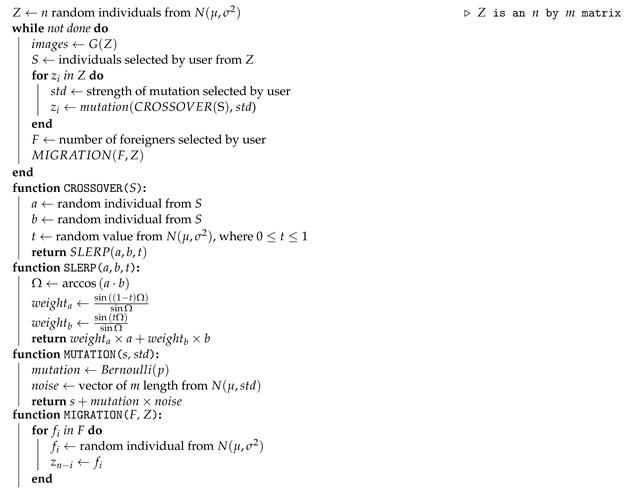 |
| Algorithm 2: StyleIE. Defaults: , , , , mapping network of StyleGAN. |
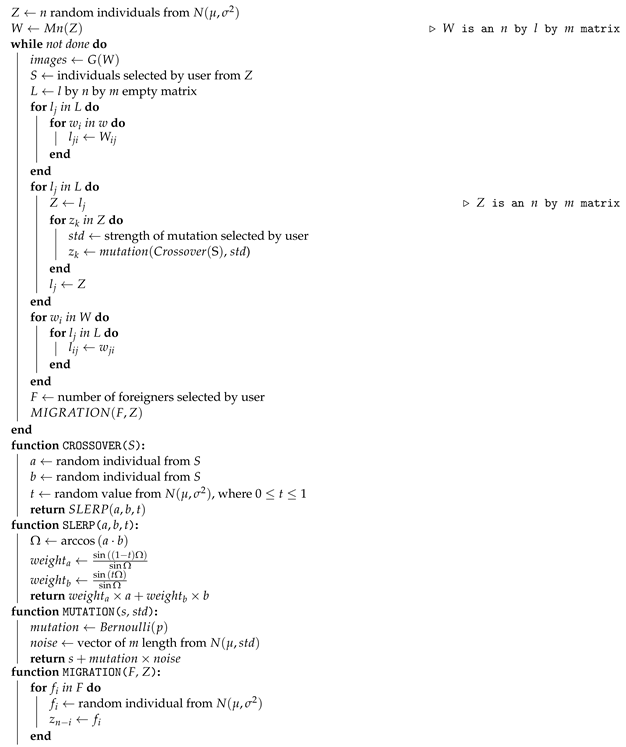 |
4. Methodology
4.1. Experimental Design
- In the first experiment, volunteers were tasked to generate an artistic image belonging to a determined genre and artistic style—in this case, an expressionist portrait. The rationale behind this choice was to give the users a set of constraints to direct their search, while still being open enough to allow them room for creative and artistic expression. The expressionist portrait goal was chosen because expressionism is a distinctive artistic style that is neither under nor overrepresented in the training dataset (see Table 1). Thus, finding an instance of expressionist art in the search space should be neither too easy nor too hard. On the other hand, portrait is one of the most straightforward genres in painting, so we reduced some of the ambiguity inherent to artistic tasks. Moreover, portrait is the most common paint genre in the WikiArt dataset [36].
- In the second experiment, volunteers were tasked to generate an artistic image resembling a specific example, thereby introducing stronger constraints to the task. Instead of asking them to generate an open-ended expressionist portrait, we asked them to approximate a specific one: “The Scream” by Edvard Munch (see Figure 6). It should be emphasized that the instruction was not to replicate the target image but to approximate it instead.
4.1.1. The AB/BA Test Design
4.1.2. The Questionnaire
- Answer the following question with respect to version A.
- -
- Rate on a scale from 1 to 5 your success in the task.
- -
- Rate on a scale from 1 to 5 how you perceive the usefulness of the program for artistic and creative expression.
- Answer the following question with respect to version B.
- -
- Rate on a scale from 1 to 5 your success in the task.
- -
- Rate on a scale from 1 to 5 how you perceive the usefulness of the program or artistic and creative expression.
- Answer the following question with respect to both versions.
- -
- Which version do you consider better? Why?
- -
- Did you employ any kind of strategy for achieving the goal? Explain.
- -
- Do you have any observations about the creative process of the system?
4.1.3. The Interface
5. Analysis of Results
5.1. Experiment 1
5.1.1. Quantitative Survey Analysis
5.1.2. Generations Ratio
5.1.3. Qualitative Survey Analysis
- Collect distinct traits: Identifying distinct traits of the target and selecting images that present these traits. The process is continued until the desired traits are merged.
- Select best likeness: Identifying images that overall resemble more closely the target.
- Hierarchical trait selection: Similar to the first strategy, but focusing on one single trait at a time.
5.2. Experiment 2
5.2.1. Quantitative Survey Results
5.2.2. Generations Ratio
5.2.3. Qualitative Survey Analysis
- A participant commented that they preferred StyleIE because it reflected better their intention when trying to combine the image.
- Another expressed that StyleIE led to more interesting variations and could be useful to explore novel ideas.
- Another expressed that StyleIE was more predictable.
- A user noted that while he preferred DeepIE, he often found that an element he wanted to preserve got lost.
6. Discussion
7. Conclusions
7.1. Contributions
- To our knowledge, this is the first study that explores the potential of deep interactive evolutionary systems for creative exploration using students from a school of architecture, art, and design.
- This is also the first study to implement DeepIE within the style-based generator, taking advantage of the intermediate space of the mapping network to produce a more complex genotype and offering the possibility of applying crossover over disentangled features.
7.2. Limitations
Supplementary Materials
Author Contributions
Funding
Institutional Review Board Statement
Informed Consent Statement
Data Availability Statement
Acknowledgments
Conflicts of Interest
Abbreviations
| IEC | Interactive Evolutionary Computation |
| EC | Evolutionary Computation |
| EArt | Evolutionary Art |
| GAN | Generative Adversarial Network |
| StyleGAN | Style-Based Generative Adversarial Network |
| ProGAN | Progressive growing Generative Adversarial Network |
| DeepIE | Deep Interactive Evolution |
| StyleIE | Style-Based Deep Interactive Evolution |
References
- Dawkins, R. The Blind Watchmaker: Why the Evidence of Evolution Reveals a Universe without Design; Springer: Berlin/Heidelberg, Germany, 1986. [Google Scholar]
- Machado, P. Evolving Art: Past, Present and Future. ICAART 2019. [Google Scholar] [CrossRef]
- Takagi, H. Interactive evolutionary computation: Fusion of the capabilities of EC optimization and human evaluation. IEEE Xplore 2001. [Google Scholar] [CrossRef]
- Goldberg, D.E. Genetic Algorithms in Search, Optimization and Machine Learning; Addison Wesley Company: Boston, MA, USA, 1989. [Google Scholar]
- Milani, A.; Suriani, S. ADAN: Adaptive Newspapers based on Evolutionary Programming. In Proceedings of the IEEE/WIC/ACM International Conference on Web Intelligence (WI’04), Beijing, China, 20–24 September 2004; pp. 779–780. [Google Scholar] [CrossRef]
- Milani, A.; Suriani, S.; Marcugini, S. Evolutionary Online Services. In Proceedings of the 7th International Conference on Electronic Commerce, Xi’an, China, 15–17 August 2005; Association for Computing Machinery: New York, NY, USA, 2005; pp. 343–349. [Google Scholar] [CrossRef]
- Milani, A.; Leung, C.H.C.; Baioletti, M.; Suriani, S. An Evolutionary Algorithm for Adaptive Online Services in Dynamic Environment. In Applications of Evolutionary Computing; Giacobini, M., Brabazon, A., Cagnoni, S., Di Caro, G.A., Drechsler, R., Ekárt, A., Esparcia-Alcázar, A.I., Farooq, M., Fink, A., McCormack, J., et al., Eds.; Springer: Berlin/Heidelberg, Germany, 2008; pp. 626–632. [Google Scholar]
- Moscato, V.; Picariello, A.; Sperli, G. An emotional recommender system for music. IEEE Intell. Syst. 2020. [Google Scholar] [CrossRef]
- Moscato, V.; Picariello, A.; Sperlí, G. Community detection based on Game Theory. Eng. Appl. Artif. Intell. 2019, 85, 773–782. [Google Scholar] [CrossRef]
- Bontrager, P.; Lin, W.; Togelius, J.; Risi, S. Deep interactive evolution. In Proceedings of the International Conference on Computational Intelligence in Music, Sound, Art and Design, Parma, Italy, 4–6 April 2018; Springer: Berlin/Heidelberg, Germany, 2018; pp. 267–282, Lecture Notes in Computer Science. [Google Scholar] [CrossRef]
- Donahue, C.; McAuley, J.; Puckette, M. Adversarial Audio Synthesis. arXiv 2019, arXiv:1802.04208. [Google Scholar]
- Fadaeddini, A.; Majidi, B.; Eshghi, M. A Case Study of Generative Adversarial Networks for Procedural Synthesis of Original Textures in Video Games. In Proceedings of the 2018 2nd National and 1st International Digital Games Research Conference: Trends, Technologies, and Applications (DGRC), Tehran, Iran, 29–30 November 2018; pp. 118–122. [Google Scholar]
- Wu, J.; Zhang, C.; Xue, T.; Freeman, B.; Tenenbaum, J. Learning a Probabilistic Latent Space of Object Shapes via 3D Generative-Adversarial Modeling. In Advances in Neural Information Processing Systems; Lee, D.D., Sugiyama, M., Luxburg, U.V., Guyon, I., Garnett, R., Eds.; Curran Associates, Inc.: Red Hook, NY, USA, 2016; Volume 29, pp. 82–90. [Google Scholar]
- Xiong, W.; Luo, W.; Ma, L.; Liu, W.; Luo, J. Learning to Generate Time-Lapse Videos Using Multi-Stage Dynamic Generative Adversarial Networks. In Proceedings of the IEEE Conference on Computer Vision and Pattern Recognition (CVPR), Salt Lake City, UT, USA, 18–23 June 2018. [Google Scholar]
- Wang, Y.; Wu, C.; Herranz, L.; van de Weijer, J.; Gonzalez-Garcia, A.; Raducanu, B. Transferring GANs: Generating images from limited data. In Proceedings of the European Conference on Computer Vision (ECCV), Munich, Germany, 8–14 September 2018; pp. 218–234. [Google Scholar]
- Simon, J. Artbreeder. Available online: https://www.artbreeder.com/ (accessed on 30 May 2020).
- Tejeda Ocampo, C. The Transfiguration of the Latent Space. AI Art Gallery: NeurIPS Workshop on Machine Learning for Creativity and Design. 2019. Available online: http://www.aiartonline.com/highlights/carlos-tejeda-ocampo/ (accessed on 29 May 2020).
- Karras, T.; Laine, S.; Aila, T. A style-based generator architecture for generative adversarial networks. In Proceedings of the IEEE Conference on Computer Vision and Pattern Recognition, Long Beach, CA, USA, 15–20 June 2019; pp. 4401–4410. [Google Scholar]
- Pei, Y.; Takagi, H. Research progress survey on interactive evolutionary computation. J. Ambient. Intell. Humaniz. Comput. 2018. [Google Scholar] [CrossRef]
- Xiao, P.; Toivonen, H.; Gross, O.; Cardoso, A.; Correia, J.; Machado, P.; Martins, P.; Oliveira, H.G.; Sharma, R.; Pinto, A.M.; et al. Conceptual representations for computational concept creation. ACM Comput. Surv. (CSUR) 2019, 52, 1–33. [Google Scholar] [CrossRef]
- Goodfellow, I.; Pouget-Abadie, J.; Mirza, M.; Xu, B.; Warde-Farley, D.; Ozair, S.; Courville, A.; Bengio, Y. Generative adversarial nets. In Advances in Neural Information Processing Systems; Curran Associates, Inc.: New York, NY, USA, December 2014; pp. 2672–2680. [Google Scholar]
- Huang, H.; Yu, P.S.; Wang, C. An introduction to image synthesis with generative adversarial nets. arXiv 2018, arXiv:1803.04469. [Google Scholar]
- Arjovsky, M.; Chintala, S.; Bottou, L. Wasserstein Generative Adversarial Networks. In Proceedings of the Machine Learning Research, Convention Centre, Sydney, Australia, 6–11 August 2017; Volume 70, pp. 214–223. [Google Scholar]
- Gulrajani, I.; Ahmed, F.; Arjovsky, M.; Dumoulin, V.; Courville, A. Improved Training of Wasserstein GANs. In Proceedings of the 31st International Conference on Neural Information Processing Systems; Curran Associates Inc.: Red Hook, NY, USA, 2017; pp. 5769–5779. [Google Scholar] [CrossRef]
- Radford, A.; Metz, L.; Chintala, S. Unsupervised Representation Learning with Deep Convolutional Generative Adversarial Networks. arXiv 2016, arXiv:abs/1511.06434. [Google Scholar]
- Karras, T.; Aila, T.; Laine, S.; Lehtinen, J. Progressive Growing of GANs for Improved Quality, Stability, and Variation. In Proceedings of the International Conference on Learning Representations, Vancouver, BC, Canada, 30 April–3 May 2018. [Google Scholar]
- Manaswi, N. Generative Adversarial Networks with Industrial Use Cases: Learning How to Build GAN Applications for Retail, Healthcare, Telecom, Media, Education, and HRTech; BPB Publications, India Amazon Digital Services LLC—KDP Print US: New Delhi, India, 2020. [Google Scholar]
- Huang, X.; Belongie, S. Arbitrary Style Transfer in Real-Time with Adaptive Instance Normalization. In Proceedings of the IEEE International Conference on Computer Vision, Venice, Italy, 22–29 October 2017; pp. 1510–1519. [Google Scholar] [CrossRef]
- Cho, S.B. Towards creative evolutionary systems with interactive genetic algorithm. Appl. Intell. 2002, 16, 129–138. [Google Scholar] [CrossRef]
- Lecoutre, A.; Negrevergne, B.; Yger, F. Recognizing Art Style Automatically in painting with deep learning. In Proceedings of the Ninth Asian Conference on Machine Learning, PMLR 77:327-342, Seoul, Korea, 15–17 November 2017. [Google Scholar]
- Hertzmann, A. Aesthetics of neural network art. arXiv 2019, arXiv:1903.05696. [Google Scholar]
- Bojanowski, P.; Joulin, A.; Lopez-Pas, D.; Szlam, A. Optimizing the Latent Space of Generative Networks. In Proceedings of the 35th International Conference on Machine Learning, Stockholmsmässan, Stockholm, Sweden, 10–15 July 2018; Volume 80, pp. 600–609. [Google Scholar]
- Shoemake, K. Animating rotation with quaternion curves. In Proceedings of the 12th Annual Conference on Computer Graphics and Interactive Techniques, San Francisco, CA, USA, 22–26 July 1985; pp. 245–254. [Google Scholar]
- Semet, Y. Interactive Evolutionary Computation: A Survey of Existing Theory; University of Illinois: Champaign, IL, USA, 2002. [Google Scholar]
- Takagi, H.; Kishi, K. On-line knowledge embedding for an interactive EC-based montage system. In Proceedings of the 1999 Third International Conference on Knowledge-Based Intelligent Information Engineering Systems, Adelaide, Australia, 31 August–1 September 1999; pp. 280–283. [Google Scholar]
- WikiArt.org. Artwoks by Genere. Available online: https://www.wikiart.org/en/paintings-by-genre?sortby=1 (accessed on 29 May 2020).
- Senn, S. The AB/BA crossover: Past, present and future? Stat. Methods Med Res. 1994, 3, 303–324. [Google Scholar] [CrossRef] [PubMed]
- Kohavi, R.; Longbotham, R. Online Controlled Experiments and A/B Testing. Encycl. Mach. Learn. Data Min. 2017, 7, 922–929. [Google Scholar] [CrossRef]
- Nielsen, J.; Landauer, T.K. A Mathematical Model of the Finding of Usability Problems. In Proceedings of the INTERACT ’93 and CHI ’93 Conference on Human Factors in Computing Systems, Amsterdam, The Netherlands, 24–29 April 1993; Association for Computing Machinery: New York, NY, USA, 1993; pp. 206–213. [Google Scholar] [CrossRef]
- Kowaliw, T.; Dorin, A.; McCormack, J. Promoting creative design in interactive evolutionary computation. IEEE Trans. Evol. Comput. 2012, 16, 523. [Google Scholar] [CrossRef]
- Serag, A.; Ono, S.; Nakayama, S. Using interactive evolutionary computation to generate creative building designs. Artif. Life Robot. 2008, 13, 246–250. [Google Scholar] [CrossRef]
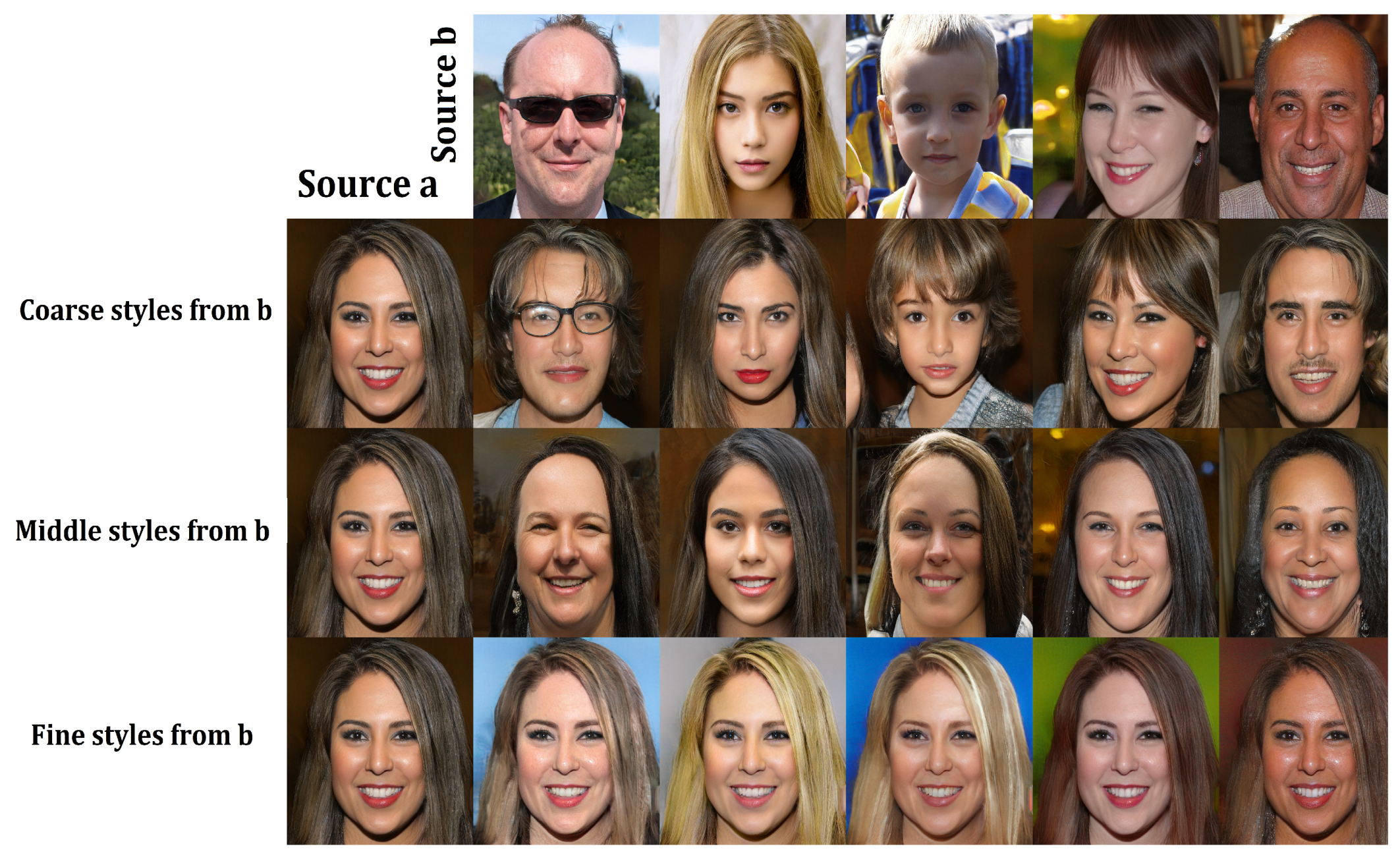
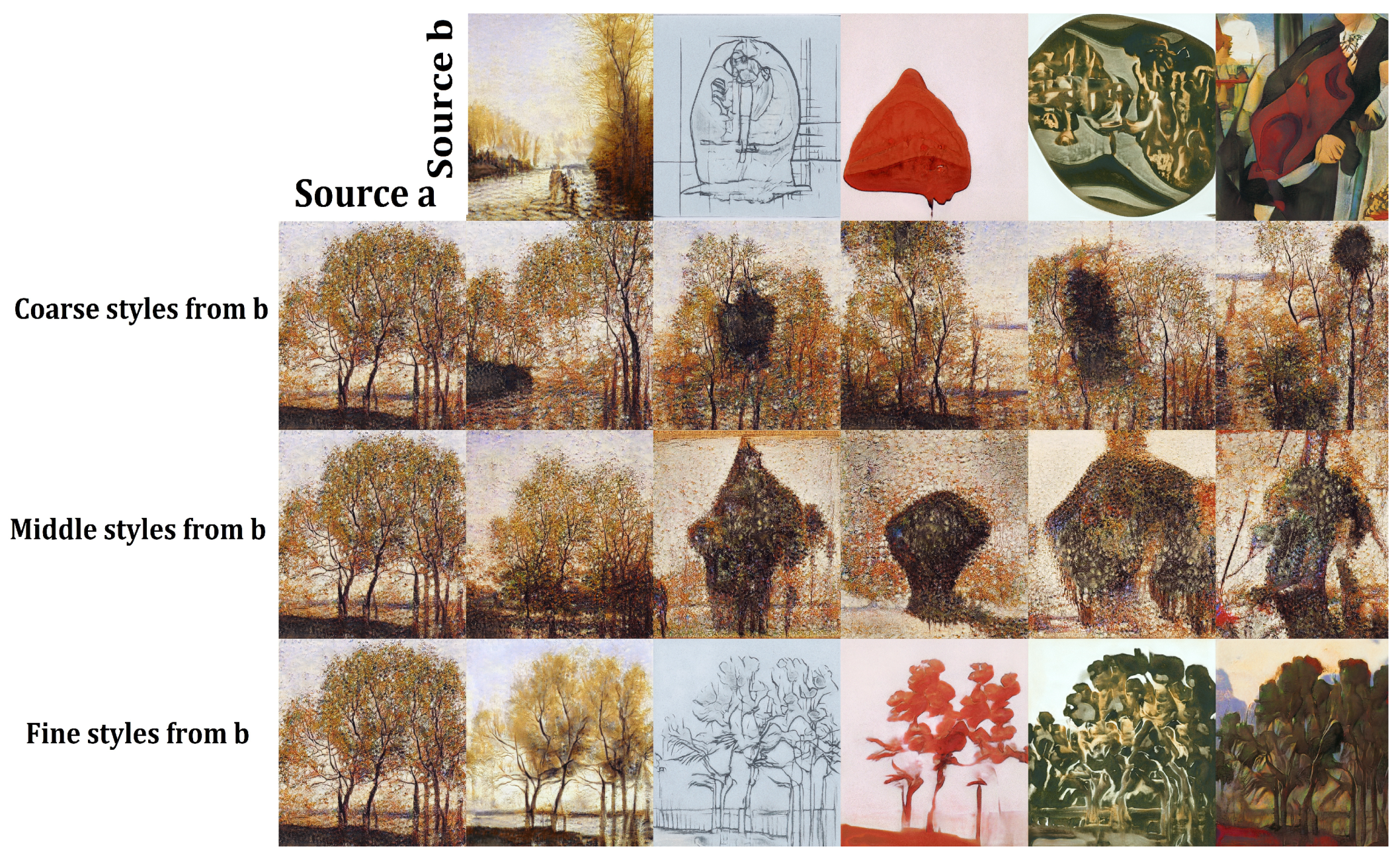
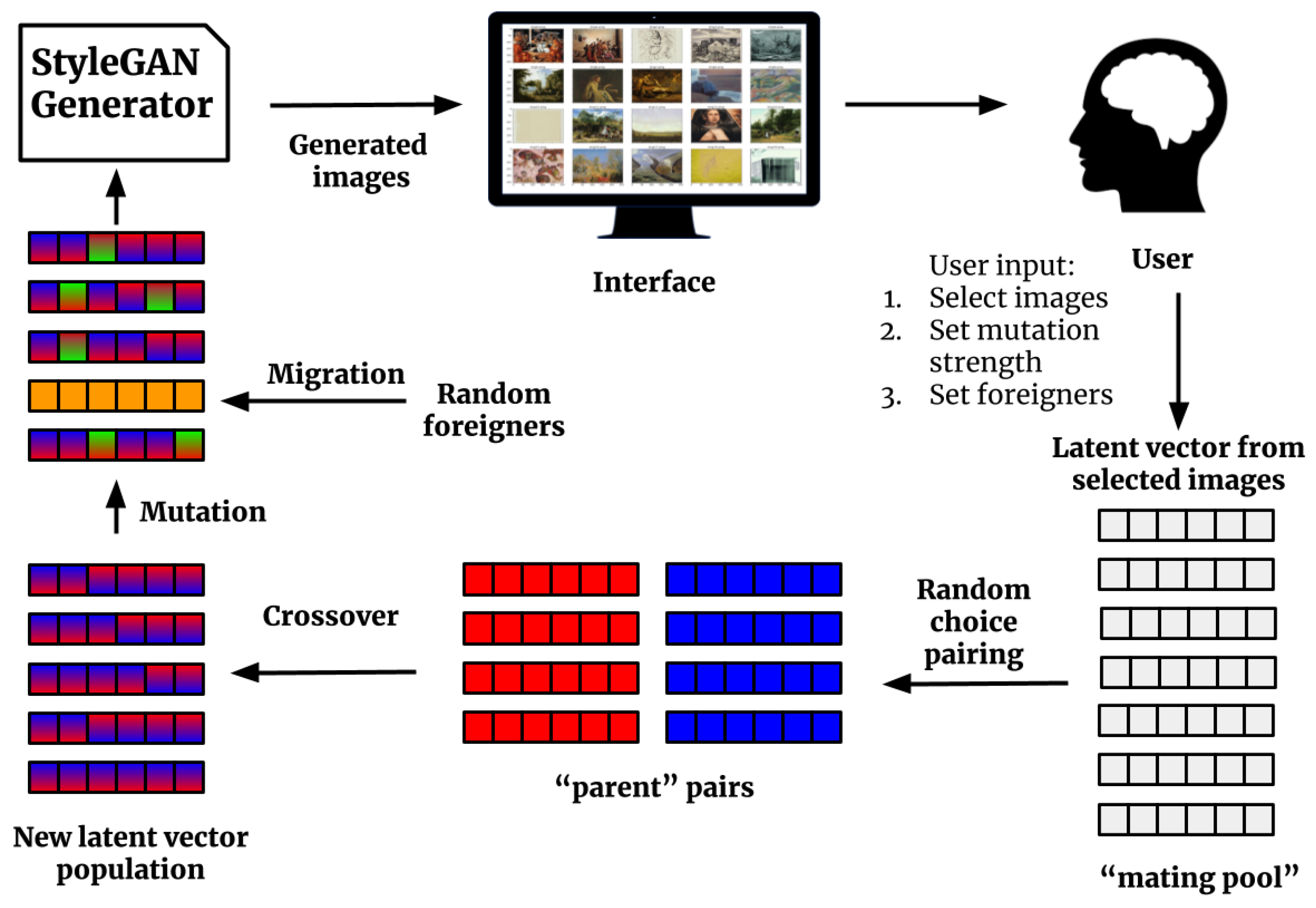
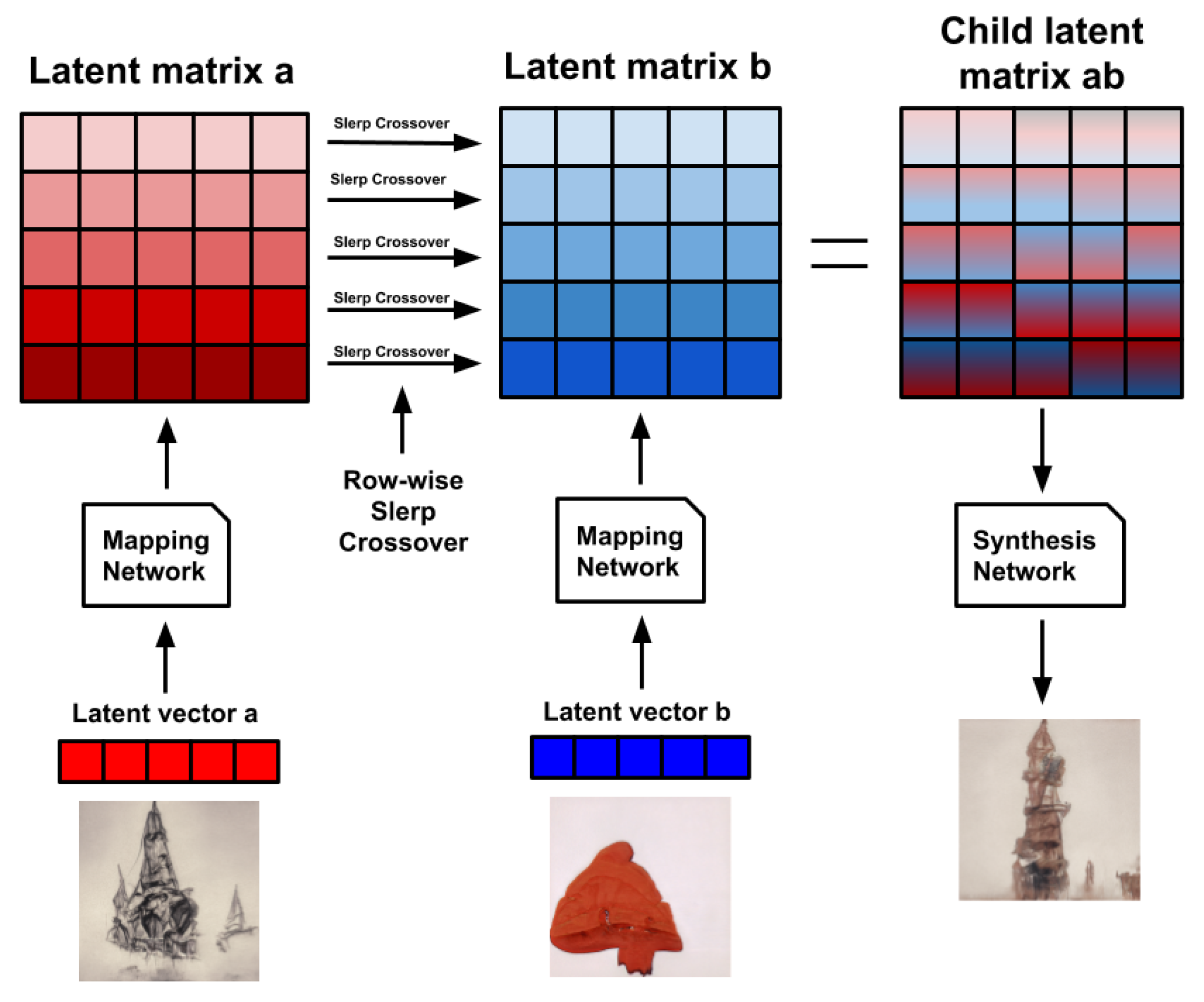
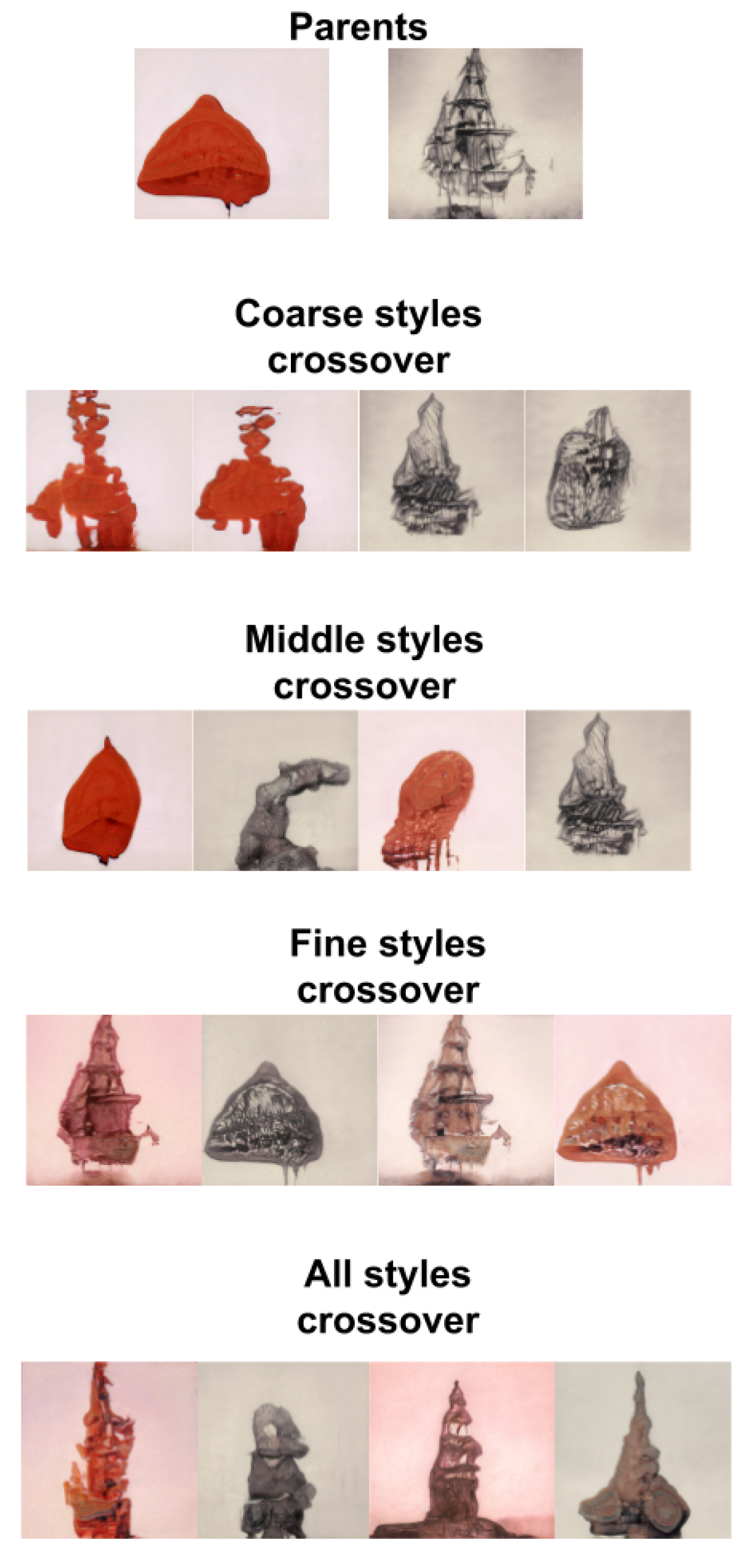
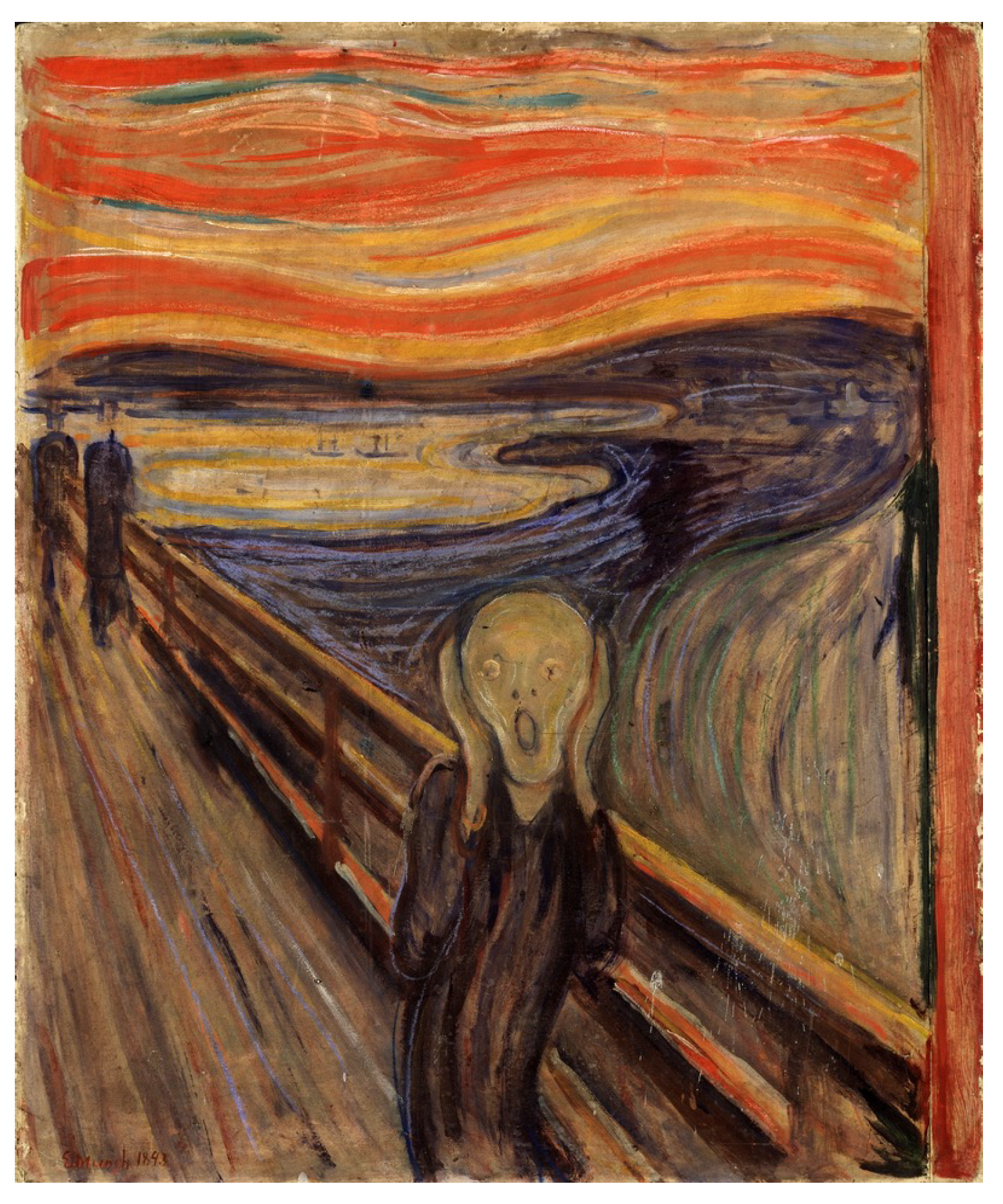
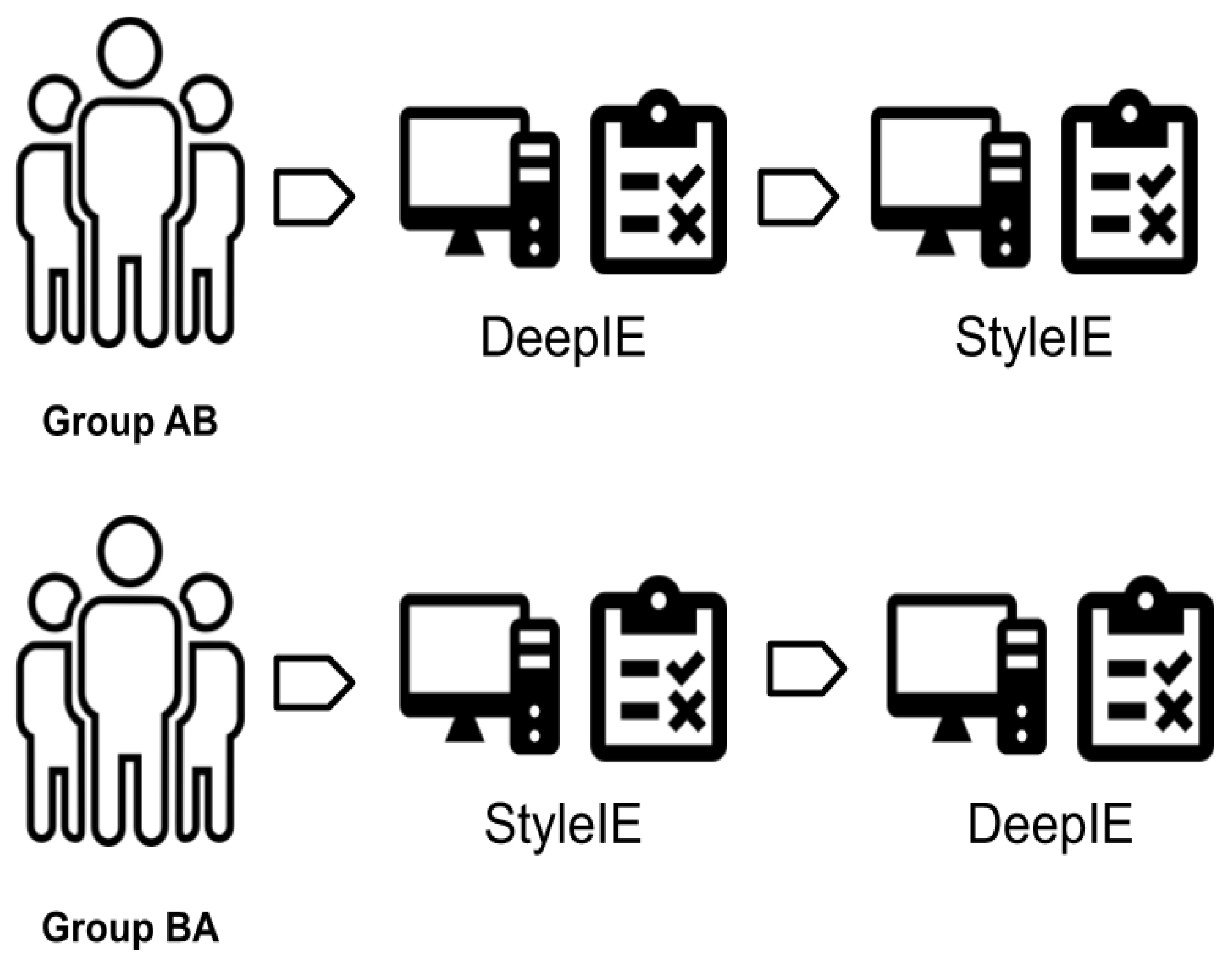
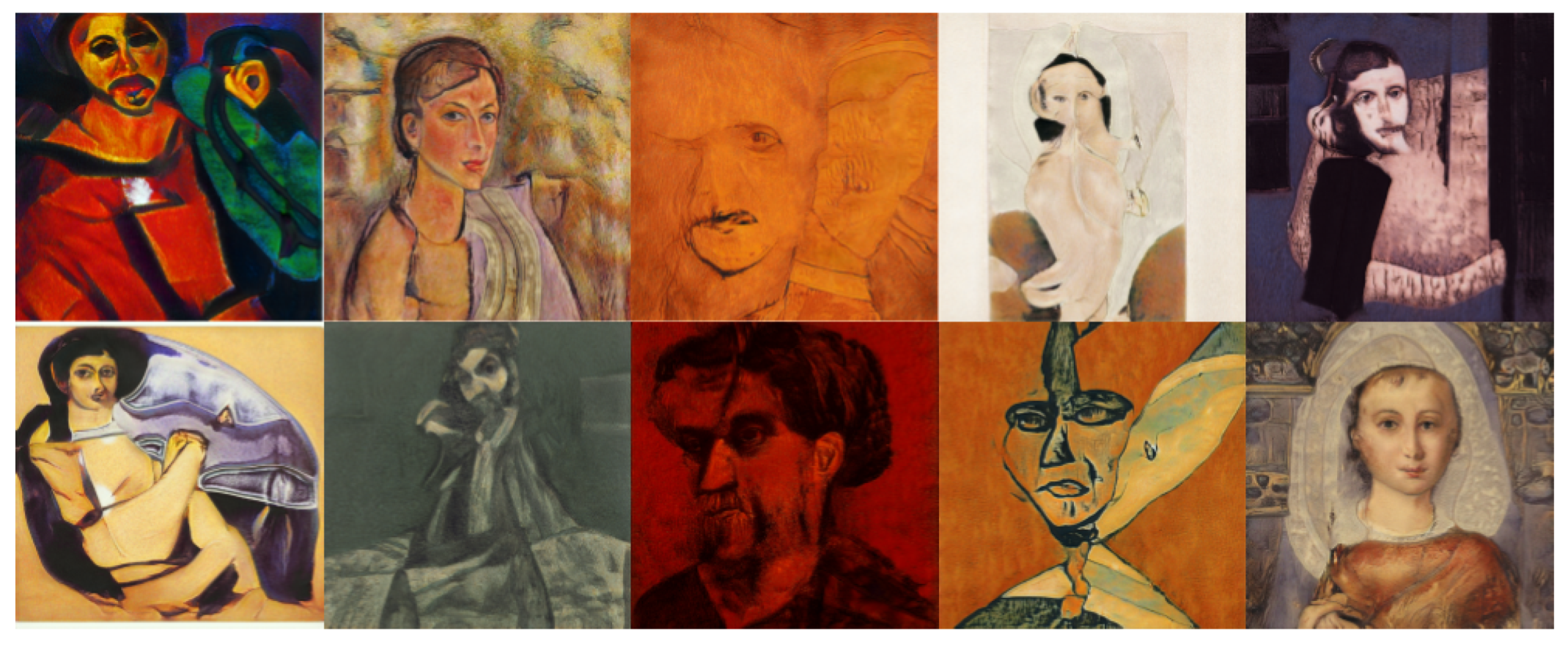

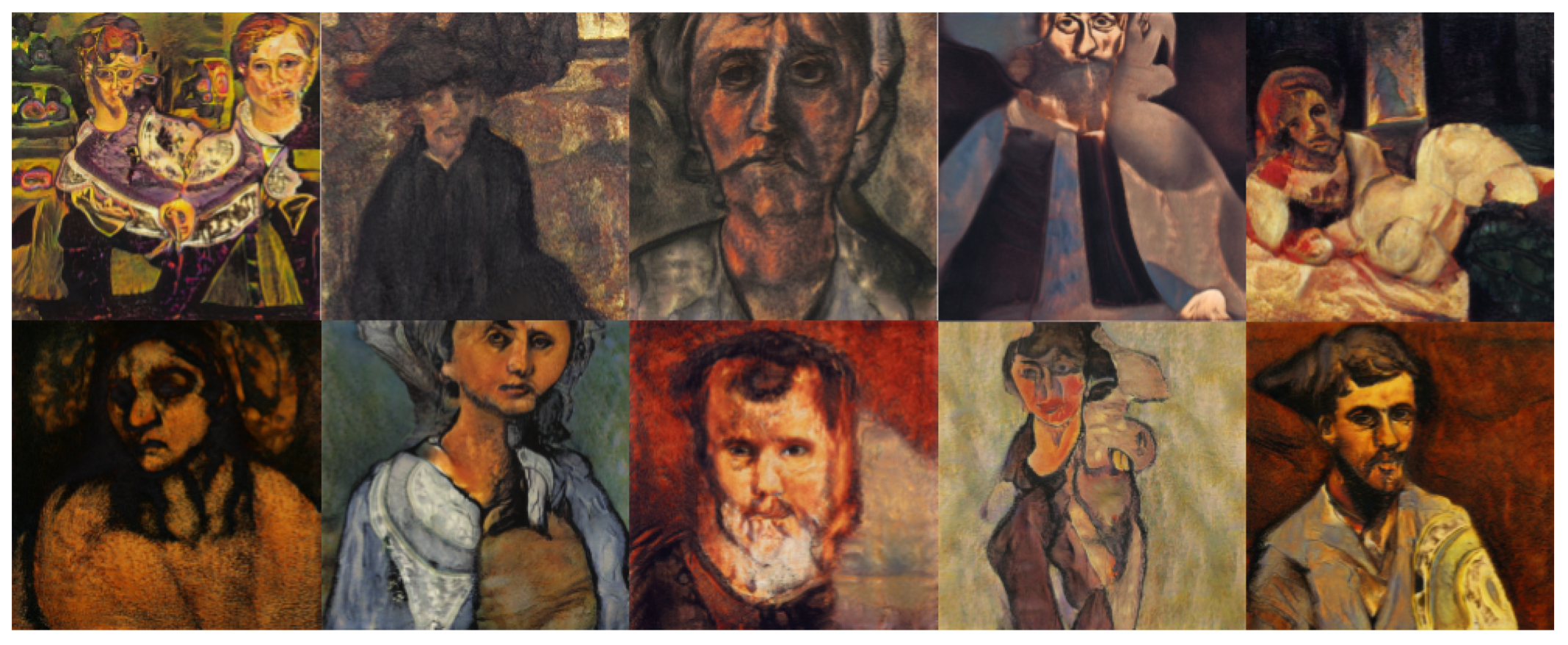
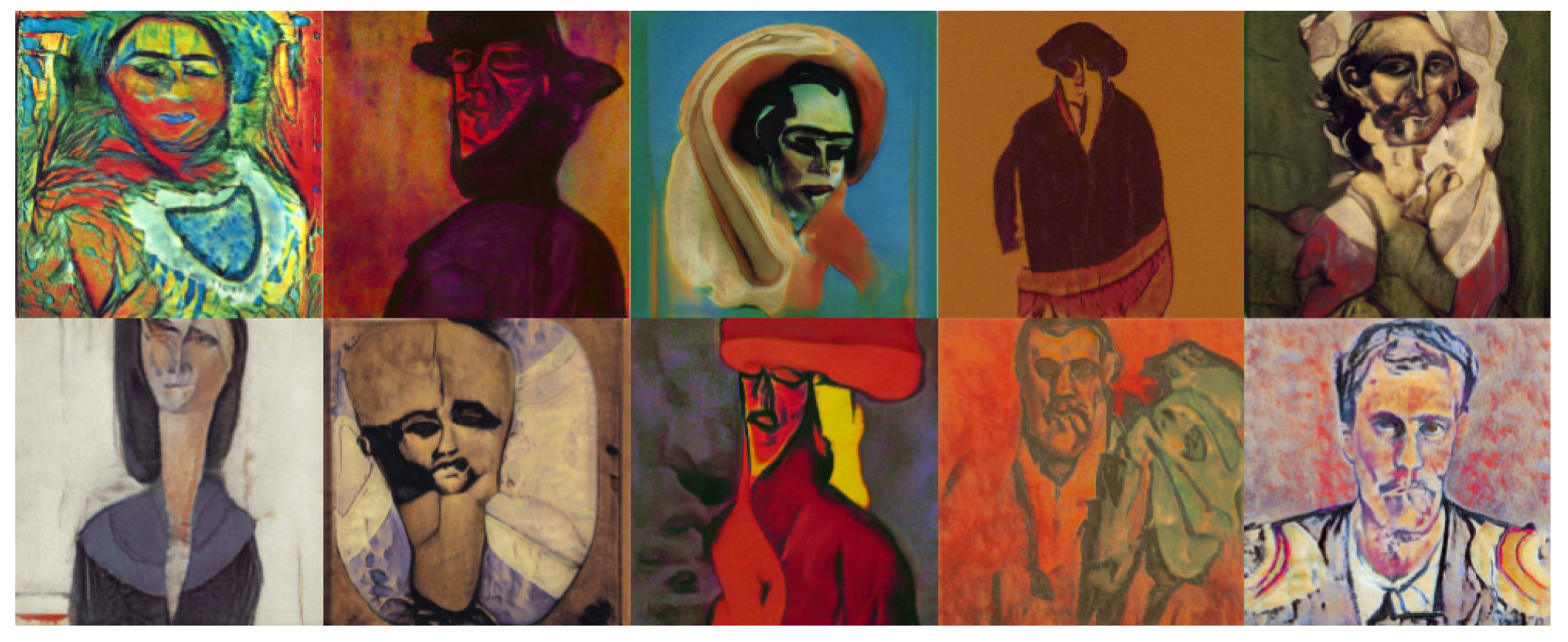
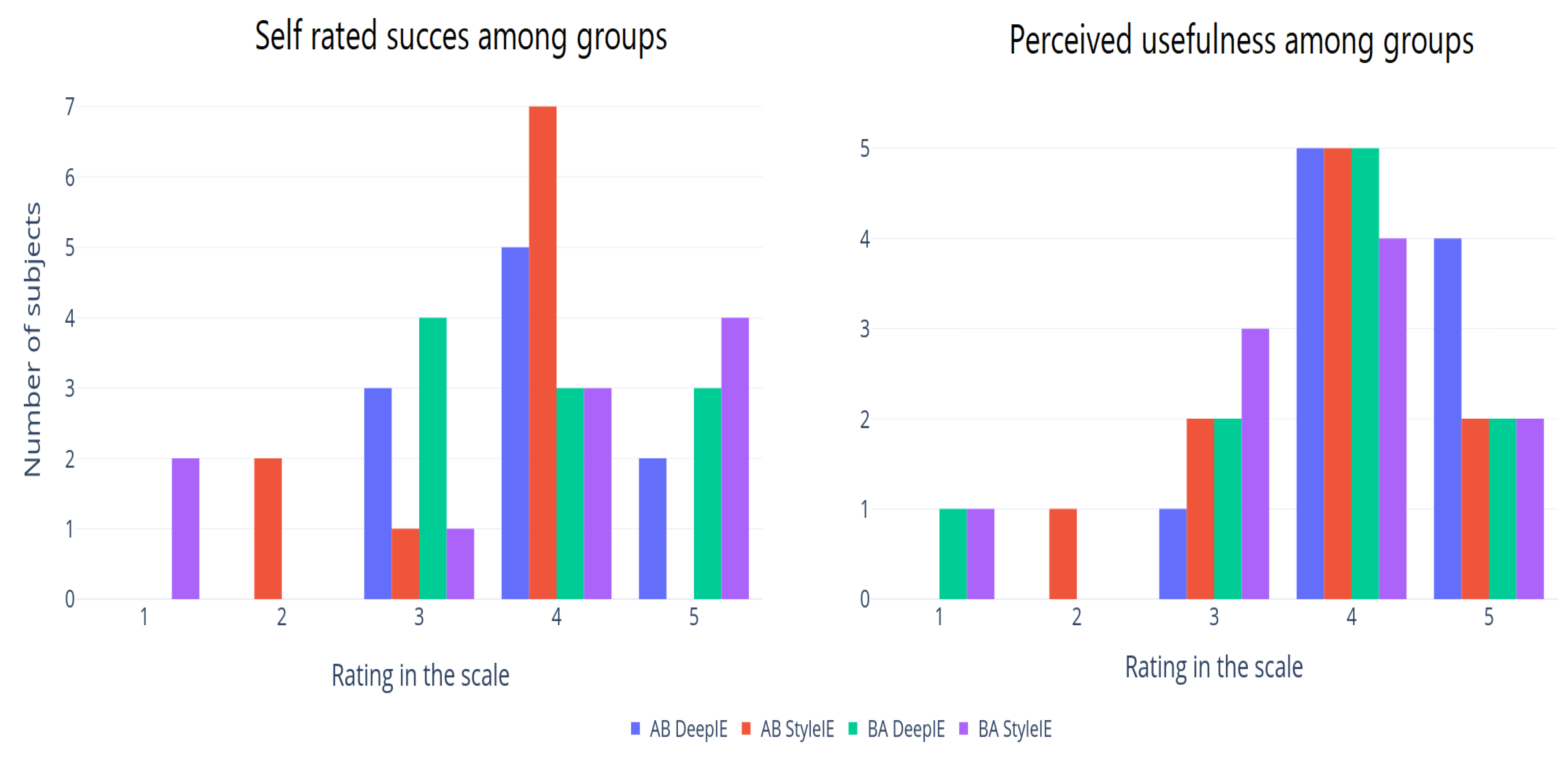
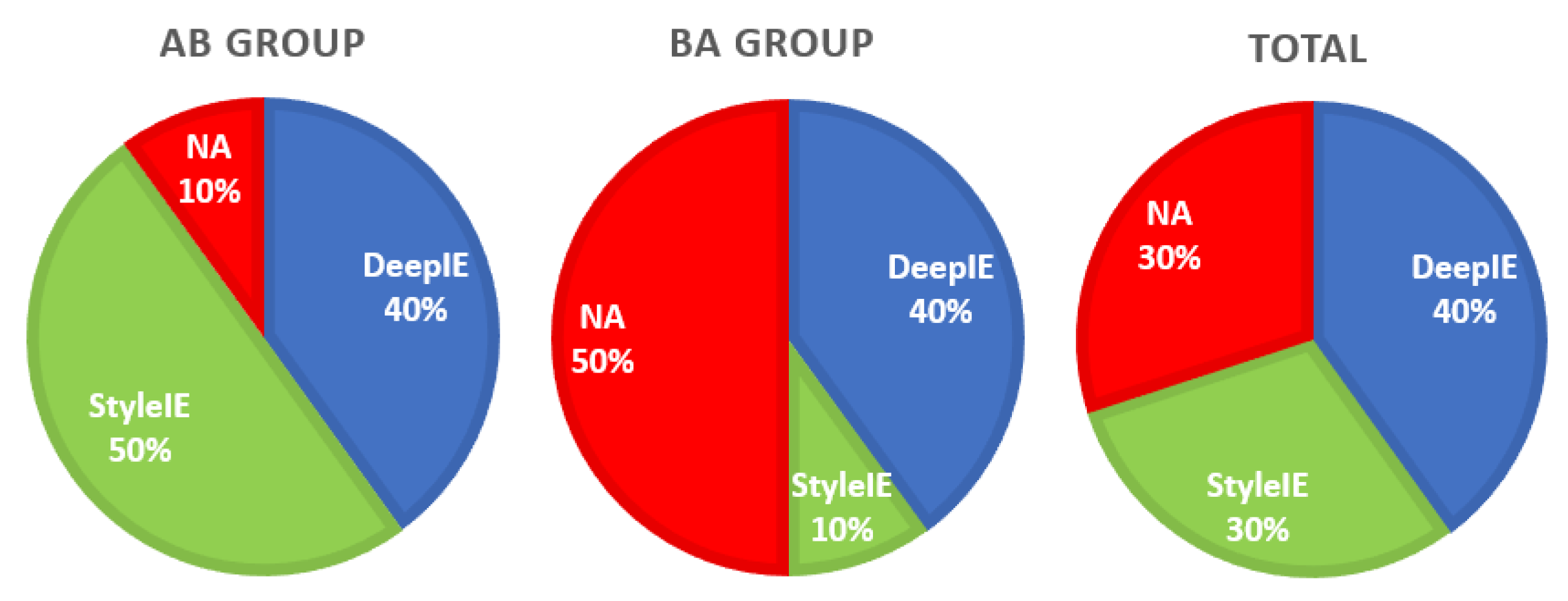


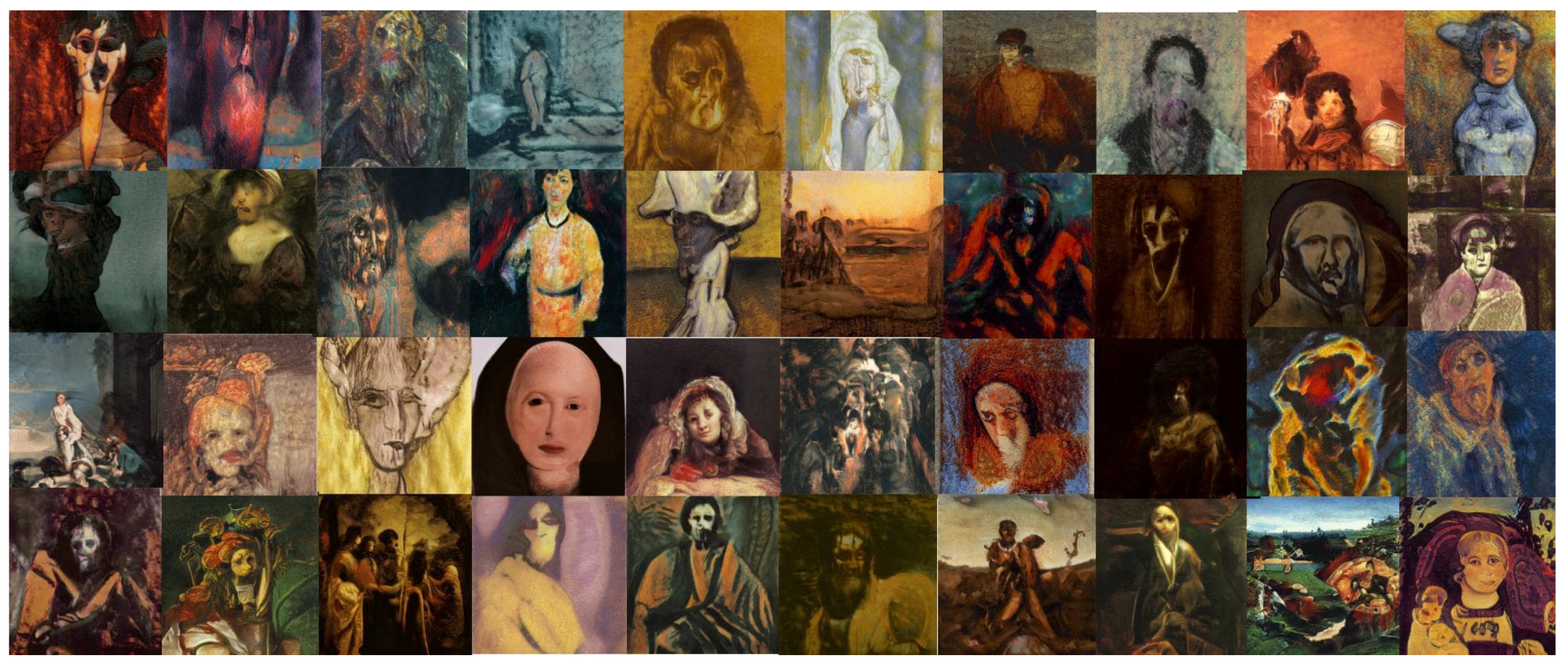
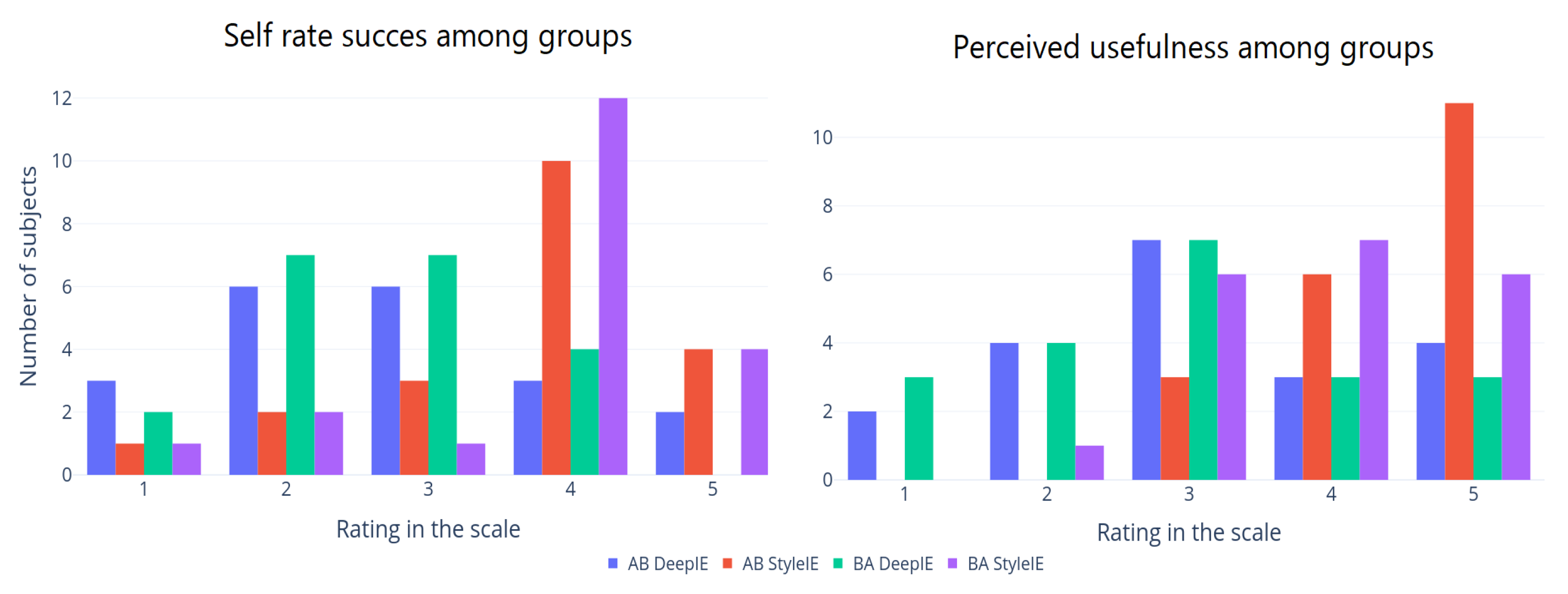
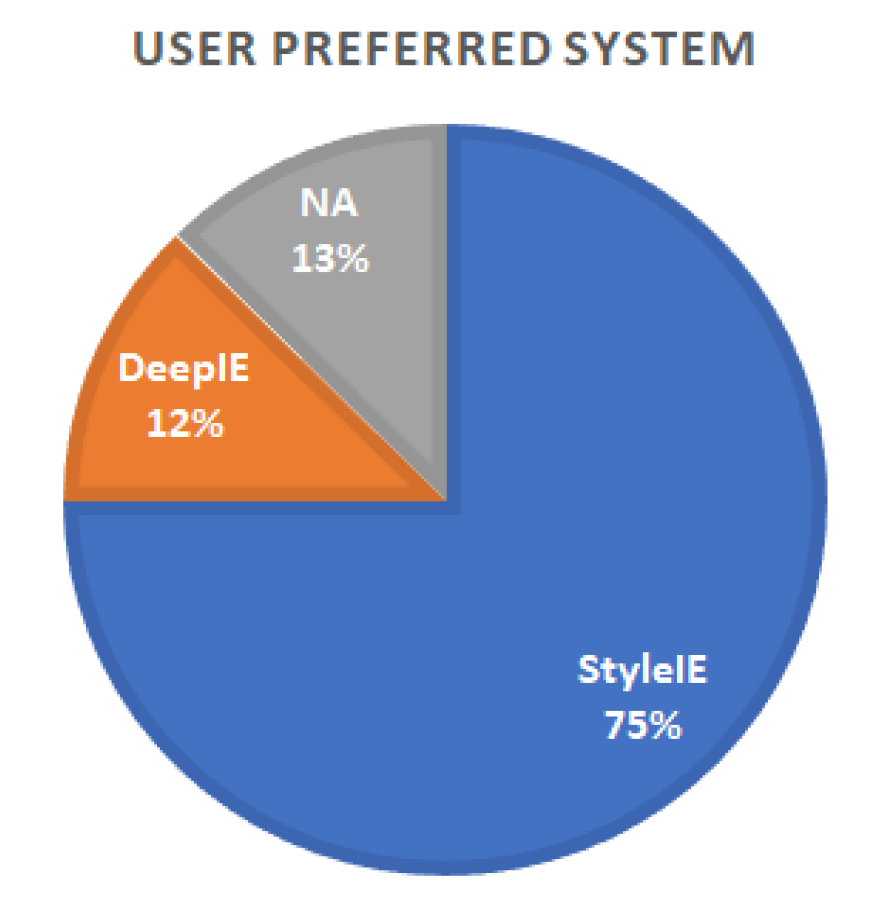
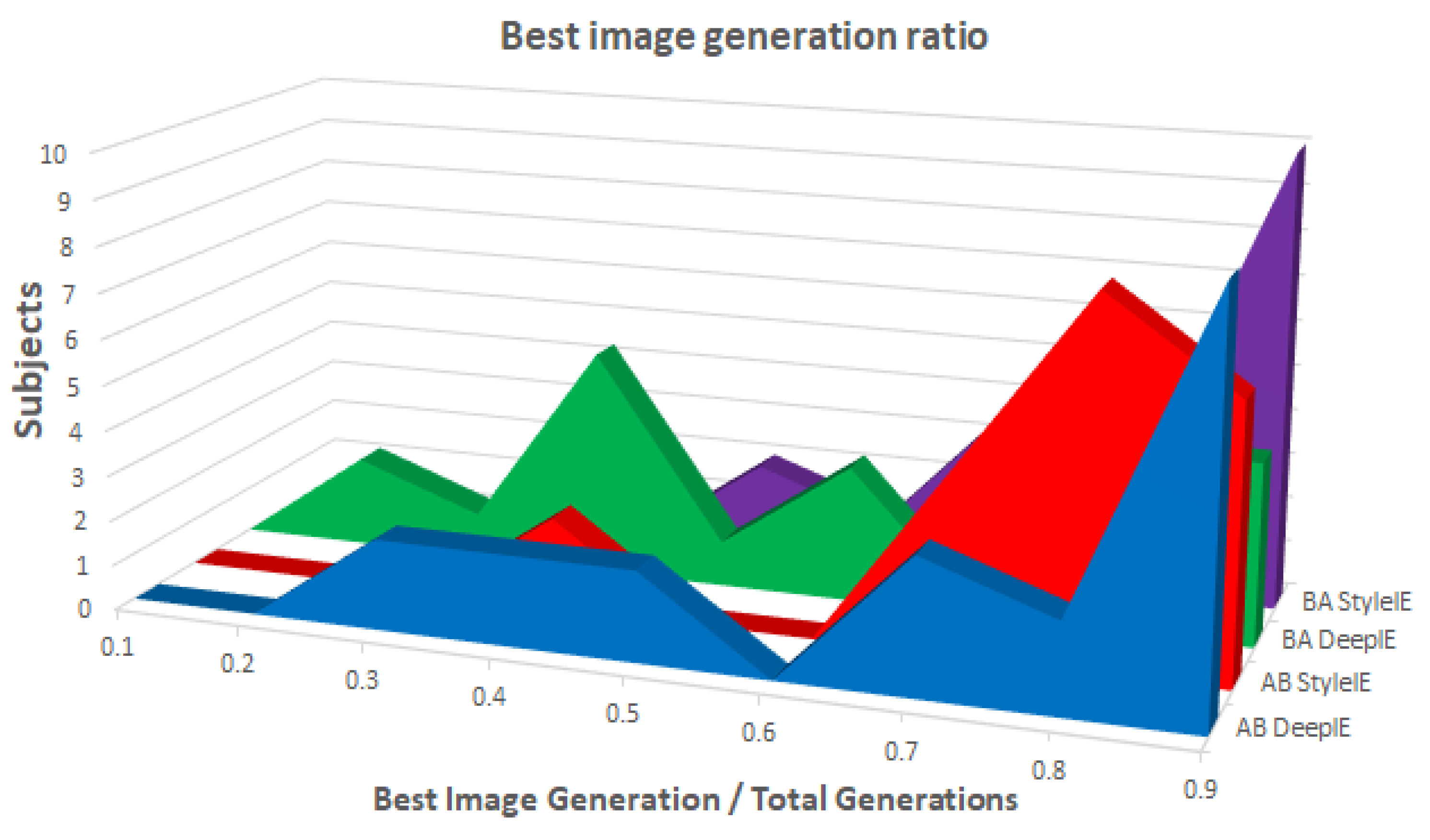
| Art Style | Number of Images | Percentage |
|---|---|---|
| Color Field Painting | 1258 | 1.53 |
| Surrealism | 4799 | 5.84 |
| Neoclassicism | 2700 | 3.28 |
| Realism | 10,090 | 12.28 |
| Baroque | 3992 | 4.86 |
| Romanticism | 6569 | 7.99 |
| Rococo | 1928 | 2.34 |
| Art Informel | 969 | 1.17 |
| Magic Realism | 1011 | 1.23 |
| Symbolism | 4063 | 4.94 |
| Naive Art (Primitivism) | 2026 | 2.46 |
| Abstract Expressionism | 2091 | 2.54 |
| Pop Art | 1129 | 1.37 |
| Expressionism | 5844 | 7.11 |
| High Renaissance | 1275 | 1.55 |
| Impressionism | 121,641 | 14.81 |
| Minimalism | 1267 | 1.54 |
| Cubism | 1686 | 2.05 |
| Abstract Art | 1006 | 1.22 |
| Post-Impressionism | 5998 | 7.30 |
| Mannerism (Late Renaissance) | 1192 | 1.45 |
| Northern Renaissance | 2405 | 2.92 |
| Art Nouveau | 4163 | 5.06 |
| Ukiyo-e | 1178 | 1.43 |
| Early Renaissance | 1330 | 1.61 |
| Total | 82,133 | 100 |
| Self-Rate Success | Perceived Usefulness | |
|---|---|---|
| AB DeepIE | 3.9 | 4.3 |
| AB StyleIE | 3.5 | 3.8 |
| BA DeepIE | 3.9 | 3.7 |
| BA StyleIE | 3.7 | 3.6 |
| AB Group | BA Group | Total | |
|---|---|---|---|
| DeepIE | 4 | 4 | 8 |
| StyleIE | 5 | 1 | 6 |
| NA | 1 | 5 | 6 |
| Total Generations | Generation of Best Image | Ratio | |
|---|---|---|---|
| AB DeepIE | 10.7 | 8.3 | 0.794 |
| AB StyleIE | 10.4 | 7.9 | 0.783 |
| BA DeepIE | 8 | 6 | 0.750 |
| BA StyleIE | 7.4 | 5.8 | 0.783 |
| Total Generations | Generation of Best Image | |
|---|---|---|
| AB DeepIE | 19.78 | 20.67 |
| AB StyleIE | 17.6 | 6.766 |
| BA DeepIE | 4.66 | 3.33 |
| BA StyleIE | 1.15 | 1.28 |
| Self-Rate Success | Perceived Usefulness | |
|---|---|---|
| DeepIE | 3.9 | 4 |
| StyleIE | 3.6 | 3.7 |
| Total Generations | Generation of Best Image | Ratio | |
|---|---|---|---|
| DeepIE | 9.35 | 7.15 | 0.772 |
| StyleIE | 8.9 | 6.85 | 0.783 |
| Self-Rate Success | Perceived Usefulness | |
|---|---|---|
| AB DeepIE | 2.75 | 3.15 |
| AB StyleIE | 3.7 | 4.4 |
| BA DeepIE | 2.65 | 2.95 |
| BA StyleIE | 3.8 | 3.9 |
| Self-Rate Success | Perceived Usefulness | |
|---|---|---|
| AB DeepIE | 2.75 | 3.15 |
| AB StyleIE | 3.7 | 4.4 |
| Self-Rate Success | Perceived Usefulness | |
|---|---|---|
| BA DeepIE | 2.65 | 2.95 |
| BA StyleIE | 3.8 | 3.9 |
| Self-Rate Success | Perceived Usefulness | |
|---|---|---|
| DeepIE | 2.7 | 3.05 |
| StyleIE | 3.75 | 4.15 |
| Total Generations | Generation of Best Image | Ratio | |
|---|---|---|---|
| AB DeepIE | 12.2 | 8.8 | 0.67 |
| AB StyleIE | 10.45 | 7.8 | 0.73 |
| BA DeepIE | 12.68 | 6.78 | 0.56 |
| BA StyleIE | 13.47 | 9.89 | 0.75 |
Publisher’s Note: MDPI stays neutral with regard to jurisdictional claims in published maps and institutional affiliations. |
© 2020 by the authors. Licensee MDPI, Basel, Switzerland. This article is an open access article distributed under the terms and conditions of the Creative Commons Attribution (CC BY) license (http://creativecommons.org/licenses/by/4.0/).
Share and Cite
Tejeda-Ocampo, C.; López-Cuevas, A.; Terashima-Marin, H. Improving Deep Interactive Evolution with a Style-Based Generator for Artistic Expression and Creative Exploration. Entropy 2021, 23, 11. https://doi.org/10.3390/e23010011
Tejeda-Ocampo C, López-Cuevas A, Terashima-Marin H. Improving Deep Interactive Evolution with a Style-Based Generator for Artistic Expression and Creative Exploration. Entropy. 2021; 23(1):11. https://doi.org/10.3390/e23010011
Chicago/Turabian StyleTejeda-Ocampo, Carlos, Armando López-Cuevas, and Hugo Terashima-Marin. 2021. "Improving Deep Interactive Evolution with a Style-Based Generator for Artistic Expression and Creative Exploration" Entropy 23, no. 1: 11. https://doi.org/10.3390/e23010011
APA StyleTejeda-Ocampo, C., López-Cuevas, A., & Terashima-Marin, H. (2021). Improving Deep Interactive Evolution with a Style-Based Generator for Artistic Expression and Creative Exploration. Entropy, 23(1), 11. https://doi.org/10.3390/e23010011







